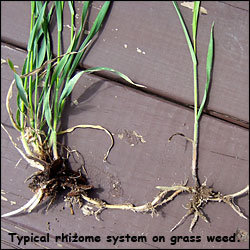





Any grassy weed that shows up where it doesn't belong is usually referred to as "crabgrass." Regardless of what we call them, the grassy weeds that grow faster than anything else in the garden are difficult to identify, and even more difficult to control.
Witchgrass, quackgrass, goosegrass, dallisgrass, and true crabgrass--it doesn't matter what you call them, these grass weeds are tenacious invaders of our lawns and flower beds. For control in turf-grass, the best method is maintaining a healthy, vigorous lawn that crowds out these unwanted relatives. In a lawn that is sparse and poorly, the only method that gives results is application of species-dedicated post-emergent herbicides (such as those containing clethodim or fluazifop) or pre-emergent products such as Dimension® (dithiopyr) or Tupersan® (siduron). Most turfgrass experts recommend the pre-emergent products as the best method.
Pre-emergent herbicides prevent weed seeds from germinating. The products are applied usually in the fall and again in spring to catch both annual weeds and perennials. Post-emergent herbicides are require contact with the growing portion of the weed and do not prevent seeds from germinating. Each product is different, so be sure to read the instructions, warnings, and proper handling details.
 The biggest problem when dealing with these grass weeds is their vigorous reproductive capabilities. Many of them spread by both underground rhizome systems as well as seeds. When digging clumps of these weeds, chopping up the rhizomes into smaller pieces simply generates that many more new plants if the pieces are left in the soil. The seeds present another problem, aside from expanding the invasion in turf-grass. The seeds are easily spread by wind, mowing, and birds into bordering flower beds, and the vicious cycle repeats itself. Young plants are easily pulled, but much less easily treated with herbicides. The risk of overspray or wind drift is too great to chance treating these weeds in a prized flowerbed, unless you are very careful. (For a quick and safe way to treat weeds and destructive insect pests, see "How To Spray Weeds and Insects Without Killing Everything".)
The biggest problem when dealing with these grass weeds is their vigorous reproductive capabilities. Many of them spread by both underground rhizome systems as well as seeds. When digging clumps of these weeds, chopping up the rhizomes into smaller pieces simply generates that many more new plants if the pieces are left in the soil. The seeds present another problem, aside from expanding the invasion in turf-grass. The seeds are easily spread by wind, mowing, and birds into bordering flower beds, and the vicious cycle repeats itself. Young plants are easily pulled, but much less easily treated with herbicides. The risk of overspray or wind drift is too great to chance treating these weeds in a prized flowerbed, unless you are very careful. (For a quick and safe way to treat weeds and destructive insect pests, see "How To Spray Weeds and Insects Without Killing Everything".)
So--how do you identify the various grass weeds? And is it important to do so? Probably not--most of them reproduce and grow in much the same conditions, and respond to control in the same ways. Here's a run-down on the most common of the weed grasses.
Crabgrass (Digitaria spp.): Also known as crowfoot grass, summer grass. Annual. Mature plant is low-growing with dark green 5-inch basically smooth leaves. Flower heads are similar to bermudagrass (Cynodon dactylon). Best control is through increasing turf-grass vigor and reducing crabgrass seed-setting by regular mowing.
Witchgrass (Panicum capillare): Also known as tumbleweedgrass, witches hair, moussell. Annual. The plant branches from the base with hairy stems and swollen bases. Matures at 1 to 2 feet tall, with large spikelets bearing a single seed at the tip of each branch.
Quackgrass (Elytrigia repens): Also known as couch grass, devils grass, knot grass, quick grass, quitch grass, scutch grass, twitch, wheat grass. Perennial. A creeping grass with sharp-tipped rhizomes that travel great distances before surfacing. Plantlets form from any of the nodules along the rhizomes. Mature plant can reach 4 feet tall, has smooth, round stems, and finely ribbed gray-green or dark green leaves that sometimes reach 8 to 12 inches long. Flower heads resemble wheat heads. Grows in all soil types and is highly drought-tolerant. Quackgrass is sometimes used as forage.
Goosegrass (Eleusine indica): Also known as silver crabgrass. Annual. Mature plant forms a rosette of flat stems to 2 feet long, with a fibrous root system. The plant does not root at the stem nodes. Leaves are flat or folded, dark green, and grow to 12 inches. Blooms in July-September on flattened spikes that resemble a zipper. Grows in poor soil, full sun, and tolerates close mowing.
Dallisgrass (Paspalum dilatatum): Sometimes confused with knotgrass (Paspalum distichum) or Bahiagrass (Paspalum notatum). Perennial. Mature plant grows in a clump, increasing in diameter while center portion dies. The short rhizomes have short internodes (length of stem between joints) which distinguishes dallisgrass from other clumping grasses. Leaves are up to 1/2-inch wide and 4 to 10 inches long, growing from stems that are sometimes purplish at the base. Flower stalk can grow to 65 inches tall, consisting of up to 10 drooping branchlets with two rows of seeds along entire length. Flourishes in high temperatures, poorly drained areas, and most soil types, and is drought- and frost-tolerant. Dallisgrass is highly susceptible to ergot fungi, which is toxic to livestock; for this reason, dallisgrass is seldom used for forage.
Armed with a little knowledge of these grass family weeds, plus some determination to be the victor, we can keep them out of our yards and gardens.
Resources
University of California Statewide Integrated Pest Management Program, UC IPM Online
Ohio State University, OARDC, Ohio Perennial & Biennial Weed Guide
Copyright © www.100flowers.win Botanic Garden All Rights Reserved